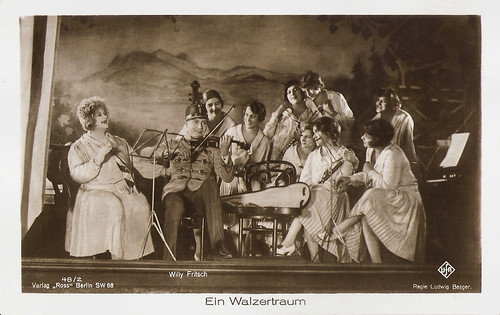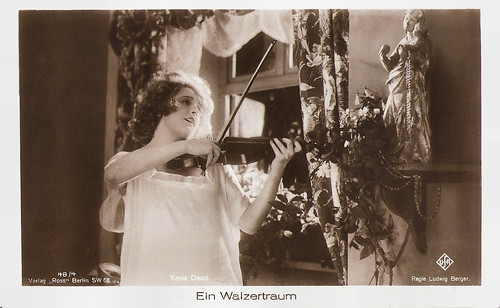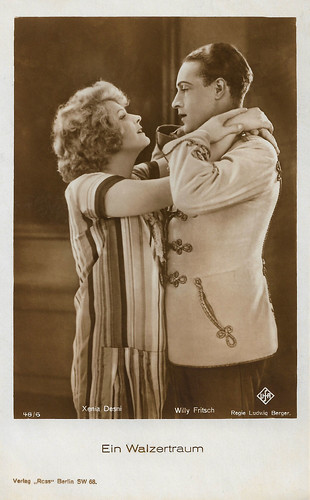
German postcard by Ross Verlag, no. 48/1. Mady Christians and Willy Fritsch in the Ufa-film Ein Walzertraum (Ludwig Berger, 1925).

German postcard by Ross Verlag, no. 48/2. Photo: Ufa. Lydia Potechina (left) and Willy Fritsch in Ein Walzertraum/The Waltz Dream (Ludwig Berger, 1925).
An internationally successful operetta
Originally, 'Ein Walzertraum' was one of the best-known operettas by Oscar Straus, a Viennese composer of operettas and film scores and songs. The German libretto was by Leopold Jacobson and Felix Dörmann, based on the novella 'Nux, der Prinzgemahl' (Nux, the Prince Consort) by Hans Müller-Einigen from his 1905 book 'Buch der Abenteuer' (Book of Adventures).
The young Jacobson presented Oscar Straus with a libretto for 'Ein Walzertraum' at a coffee house in the Vienna Prater in 1906. Straus was inspired by the text and completed the work within 12 months. 'Ein Walzertraum' premiered on 2 March 1907 at the Carltheater in Vienna.
Following the success of the operetta in Vienna, productions of the work, under the name 'A Waltz Dream', were mounted in English for premieres at the Chestnut Street Opera House in Philadelphia on 6 January 1908, in New York City at the now-demolished Broadway Theatre on 27 January 1908 (with an English libretto adapted by Joseph Herbert), and in London on 28 March 1908 at the Hicks Theatre (adapted by Basil Hood, with lyrics by Adrian Ross, starring Gertie Millar and W.H. Berry). Lily Elsie and Amy Evans starred in the 1911 revival at Daly's Theatre.
The international success of the operetta exceeded Straus's expectations, and special praise was reserved for the famous waltz theme from Act Two. Straus later arranged various numbers from the operetta and included the graceful main waltz theme into a new concert waltz. The piece made Straus's international reputation, touring internationally after the Vienna, New York and London run and enjoying many revivals. The operetta did not remain as popular over the decades as Straus' 'The Chocolate Soldier', but several modern productions have been mounted. In 1991, Ohio Light Opera produced the work, and in 1992, Light Opera Works of Illinois mounted a production.
Film versions of the operetta include the Hungarian silent film Varázskeringö/Magic Waltz (1918) directed by Michael Curtiz, the German film Ein Walzertraum/The Waltz Dream (1925) directed by Ludwig Berger, and releases in Finland (1926) and Poland (1931). Ernst Lubitsch made the best-known film version, The Smiling Lieutenant (1931), starring Maurice Chevalier and Claudette Colbert.

German postcard by Ross Verlag, no. 48/3. Photo: Ufa. Xenia Desni and Willy Fritsch in Ein Walzertraum/The Waltz Dream (Ludwig Berger, 1925).

German postcard by Ross Verlag, no. 48/4. Photo: Ufa. Xenia Desni in Ein Walzertraum/The Waltz Dream (Ludwig Berger, 1925).
The amorous lieutenant and the princess
Erich Pommer produced for the Ufa a wonderful silent film version of the operetta, Ein Walzertraum/The Waltz Dream (Ludwig Berger, 1925), with a great cast and fine exterior shots at the famous Imperial Schloss Schönbrunn.
Sunnyboy Willy Fritsch plays the amorous lieutenant Nicholas Count Preyn of the Austrian royal guard. 'Niki' has a new girlfriend, the violin-playing Franzi Steingruber (Xenia Desni). He's crazy about her and is smiling at her while on duty in the street. King Eberhard XXIII (Jacob Tiedtke) and his daughter Princess Alix (Mady Christians) from the neighbouring kingdom of Flausenthurm drive by, and Alix intercepts a wink meant for Franzi.
The princess falls for Niki, marries him (he has no choice in the matter), and whisks him off to Flausenthurm. Franzi follows and enjoys a brief affair with Niki before Anna finds out. Franzi, much more experienced in the ways of the world, gives the socially awkward princess Alix lessons on how to win the affection of her husband.
The cast of Ein Walzertraum/The Waltz Dream also included such great character actors as Lydia Potechina, Mathilde Sussin, Karl Beckersachs, Julius Falkenstein, Hans Brausewetter and Lucie Höflich. The film was a great box office hit but also a critical success. For director Ludwig Berger, Ein Walzertraum/The Waltz Dream brought an invitation to Hollywood.
In Germany, Ein Walzertraum/The Waltz Dream led to a wave of silent operetta and Vienna films. In the sound era, this genre culminated in the world hit Der Kongress tanzt/The Congress dances (Erik Charell, 1931) with Lilian Harvey and of course Willy Fritsch.

German postcard by Ross Verlag, no. 48/5. Photo: Ufa. Publicity still for Ein Walzertraum/The Waltz Dream (Ludwig Berger, 1925) with Xenia Desni and Willy Fritsch.

German postcard by Ross Verlag, no. 48/6. Photo: Ufa. Xenia Desni and Willy Fritsch in Ein Walzertraum/The Waltz Dream (Ludwig Berger, 1925).

German collectors card by Ross Verlag in the series Vom Werden deutscher Filmkunst - Der Stumme Film, picture no. 115, group 40. Photo: Ufa. Publicity still for Ein Walzertraum/A Waltz-Dream (Ludwig Berger, 1925) with Mady Christians and Willy Fritsch.
Sources: Wikipedia (English and German), and IMDb.
This post was last updated on 1 January 2024.
No comments:
Post a Comment